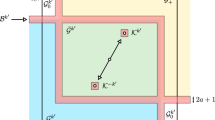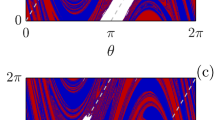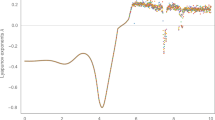Abstract
In this paper, we give a quantitative estimate for the first N Lyapunov exponents for random perturbations of a natural class of 2N-dimensional volume-preserving systems exhibiting strong hyperbolicity on a large but noninvariant subset of the phase space. Concrete models covered by our setting include systems of coupled standard maps, in both ‘weak’ and ‘strong’ coupling regimes.
Similar content being viewed by others
Notes
In other words, for each \(1 \le j \le d\), we set the j-th component \((\Delta _i(z))_j\) to be \(\{(z - z_i)_j\} - 1/2\), where here for \(\alpha \in \mathbb {R}\) we write \(\{ \alpha \} = \alpha - \lfloor \alpha \rfloor \in [0,1)\) for the fractional part of \(\alpha \), and \((z - z_i)_j\) is the j-th coordinate of \(z - z_i\).
That is, we are abandoning for the moment the distinction between x and y coordinates in \(\mathbb {T}^d = \mathbb {T}^{2N}\).
References
Barreira, L., Pesin, Y.B.: Lyapunov Exponents and Smooth Ergodic Theory, vol. 23. American Mathematical Society, Providence (2002)
Berger, P., Carrasco, P.: Non-uniformly hyperbolic diffeomorphisms derived from the standard map. Commun. Math. Phys. 329, 239–262 (2014)
Berger, P., Turaev, D.: On Herman’s positive entropy conjecture. Adv. Math. 349, 1234–1288 (2019)
Blumenthal, A., Xue, J.X., Young, L.S.: Lyapunov exponents for random perturbations of some area-preserving maps including the standard map. Ann. Math. 185, 285–310 (2018)
Boffetta, G., del Castillo-Negrete, D., López, C., Pucacco, G., Vulpiani, A.: Diffusive transport and self-consistent dynamics in coupled maps. Phys. Rev. E 67(2), 026–224 (2003)
Breden, M., Engel, M.: Computer-assisted proof of shear-induced chaos in stochastically perturbed hopf systems. (2021). arXiv preprint arXiv: 2101.01491
Carrasco, P.D.: Random products of standard maps. (2019). https://arxiv.org/abs/1705.09705
Chirikov, B., Shepelyansky, D.: Chirikov standard map. Scholarpedia 3(3), 3550 (2008)
Chirikov, B.V.: A universal instability of many-dimensional oscillator systems. Phys. Rep. 52(5), 263–379 (1979)
Duarte, P.: Plenty of elliptic islands for the standard family of area preserving maps. In: Annales de l’IHP Analyse nonlinéaire, vol. 11, pp. 359–409 (1994)
Furstenberg, H.: Noncommuting random products. Transactions of the American Mathematical Society, pp. 377–428 (1963)
Galatolo, S., Monge, M., Nisoli, I.: Existence of noise induced order, a computer aided proof. Nonlinearity 33(9), 4237 (2020)
Gol’dsheid, I.Y., Margulis, G.A.: Lyapunov indices of a product of random matrices. Russ. Math. Surv. 44(5), 11–71 (1989)
Gorodetski, A.: On stochastic sea of the standard map. Commun. Math. Phys. 309(1), 155–192 (2012)
Guivarch, Y., Raugi, A.: Products of random matrices: convergence theorems. Random Matrices and Their Applications (Brunswick, Maine, 1984) 31–54. Contemp. Math. 50, 18
Horn, R.A., Johnson, C.R.: Topics in matrix analysis. Bull. Am. Math. Soc. 27, 191–198 (1992)
Hutchings, M.: Lecture notes on Morse homology (with an eye towards floer theory and pseudoholomorphic curves) (2002)
Kantz, H., Grassberger, P.: Internal Arnold diffusion and chaos thresholds in coupled symplectic maps. J. Phys. A: Math. Gen. 21(3), 127–133 (1988)
Kato, T.: Perturbation Theory for Linear Operators, vol. 132. Springer, Berlin (2013)
Kifer, Y.: Random perturbations of dynamical systems. Nonlinear Problems in Future Particle Accelerators. World Scientific, pp. 189 (1988)
Manos, T., Skokos, C., Bountis, T.: Global Dynamics of Coupled Standard Maps, Chaos in Astronomy, pp. 367–371. Springer, Berlin (2008)
Neretin, Y.A.: On Jordan angles and the triangle inequality in Grassmann manifolds. Geom. Dedic. 86(1–3), 81–91 (2001)
Nicolaescu, L.I.: Lectures on the Geometry of Manifolds. World Scientific, Singapore (2007)
Piccione, P., Tausk, D.V. et al.: On the geometry of Grassmannians and the symplectic group: the Maslov index and its applications. UFF (2000)
Virtser, A.D.: On products of random matrices and operators. Theory Probab. Appl. 24(2), 367–377 (1980)
Wilkinson, A.: What are Lyapunov exponents, and why are they interesting? Bull. Am. Math. Soc. 54(1), 79–105 (2017)
Wood, B.P., Lichtenberg, A.J., Lieberman, M.A.: Arnold diffusion in weakly coupled standard maps. Phys. Rev. A 42(10), 58–85 (1990)
Yang, H., Radons, G.: Dynamical behavior of hydrodynamic Lyapunov modes in coupled map lattices. Phys. Rev. E 73(1), 016208 (2006)
Yang, H., Radons, G.: Lyapunov modes in extended systems. Philos. Trans. R. Soc. A: Math. Phys. Eng. Sci. 367(1901), 3197–3212 (2009)
Young, L.-S.: Mathematical theory of Lyapunov exponents. J. Phys. A: Math. Theor. 46(25), 254001 (2013)
Acknowledgements
Alex Blumenthal was supported by the National Science Foundation under Award No. DMS-1604805. Jinxin Xue is supported by NSFC (Significant Project No.11790273) in China and Beijing Natural Science Foundation (Z180003). Yun Yang is supported by the National Science Foundation under Award No. DMS-2000167.
Author information
Authors and Affiliations
Corresponding author
Additional information
Publisher's Note
Springer Nature remains neutral with regard to jurisdictional claims in published maps and institutional affiliations.
Appendices
Appendix A: Version of the Singular Value Decomposition
Lyapunov exponents are asymptotic exponential growth rates of singular values. For this reason, we recall here some basic facts about the Singular Value Decomposition and related results used in this paper. Below, \(d \ge 1\) and A is a \(d \times d\) matrix. The singular values \(\sigma _1(A) \ge \cdots \ge \sigma _d(A)\) are defined to be the eigenvalues of \(\sqrt{A^\top A}\), listed in decreasing order and counted with multiplicity.
Theorem 29
(Singular Value Decomposition, Theorem 3.1.1 of [16]). There exist orthonormal bases \(\{e_1, \cdots , e_d\}\) and \(\{e_1', \cdots , e_d'\}\) of \(\mathbb {R}^d\) with the property that
These bases are unique up to changes of sign and rearrangements of indices in case of repeated singular values (i.e., \(\sigma _i(A) = \sigma _j(A)\) for some \(i \ne j\)).
Recall that \(\{ e_i\}\) is an (orthonormal) eigenbasis for \(A^\top A\), while \(\{ e_i'\}\) is an appropriate ordering of an (orthonormal) eigenbasis for \(A A^\top \).
The following characterization of singular values is also used.
Lemma 30
(Min-max Principles for Singular Values, Theorem 3.1.2 of [16]). For all \(1 \le i \le d\), we have that
where \(A|_E\) is regarded as a linear mapping \(E \rightarrow A(E)\).
The characterization in Lemma 30 is central to the approach taken in this paper: it directly implies that to control \(\prod _1^k \sigma _j(A)\), it suffices to control the volume growth of A along k-dimensional subspaces. Since Lyapunov exponents are asymptotic exponential growth rates of singular values, this motivates why we can control sums of the top-k Lyapunov exponents by studying the ‘typical’ rate at which k-dimensional volumes grow.
Lastly, we state the following corollary of Theorem 29, which we use in Lemma 22 to estimate singular directions. Below, \(E_0\) is a k-dimensional subspace, \(\alpha > 0\) is fixed, \(\Pi _0 : \mathbb {R}^d \rightarrow E_0\) is orthogonal projection to \(E_0\), and
is a cone of vectors roughly parallel to \(E_0\).
Lemma 31
Assume A is invertible, and has the property that for any \(\ell \)-dimensional subspace \(E \subset \mathcal {C}_0\), \(\ell \le k\), we have that \(A(E) \subset \mathcal {C}_0\) and \(A^\top (E) \subset \mathcal {C}_0\). Then, \(\exists 1 \le i_1< \cdots < i_k \le d\) such that \(e_{i_j}, e_{i_j}' \in \mathcal {C}_0\) for \(1 \le j \le k\).
Proof
Let \(\mathcal {E}_0 := \{ E \in {\text {Gr}}_k(\mathbb {R}^m) : E \subset \mathcal {C}_0\}\) and observe that \(\mathcal {E}_0\) is invariant under \(B := A^\top A\), which we view as a (continuous) mapping \({\text {Gr}}_k(\mathbb {R}^m) \rightarrow {\text {Gr}}_k(\mathbb {R}^m)\). In the chart \(\mathcal {U}_{E_0}\) (see Sect. 5.1), the set \(\mathcal {E}_0\) is convex. Since \(\mathcal {E}_0\) is also compact, we see by the Brouwer fixed point theorem that B must have a fixed point in \(\mathcal {E}_0\), i.e., a k-dimensional subspace E for which \(B (E) = E\). Since B is self-adjoint, it follows that B has k linearly independent, orthogonal eigenvectors in E, from which we conclude \(\exists i_j, 1 \le j \le k\), for which \(e_{i_j} \in \mathcal {C}_0\). Applying the hypothesis to the span of \(e_{i_j}\) (\(\ell = 1\)), we conclude that \(A e_{i_j} = \sigma _{i_j}(A) e_{i_j}' \in \mathcal {C}_0\), from which it follows immediately that \(e_{i_j}' \in \mathcal {C}_0\) as well (note \(\sigma _i(A) \ne 0\) for all \(1 \le i \le d\) if A is invertible). \(\square \)
Appendix B: Proofs of Grassmanian Geometric Lemmas 19 and 21
Proof of Lemma 19
Given \(E \in {\text {Gr}}_k(\mathbb {R}^m)\), write \(V = E^\perp \) and define \(\mathcal {V}= (\mathcal {U}_E)^c\), which by point (A) at the beginning of Sect. 3 is the set of k-dimensional subspaces intersecting V nontransversally. We will describe \(\mathcal {V}\) as the image of a fiber bundle \(\mathcal {E}\), to be defined below, via a smooth mapping \(\Phi : \mathcal {E}\rightarrow {\text {Gr}}_k(\mathbb {R}^m)\). As we will show, \(\dim \mathcal {E}< k (m-k) = \dim {\text {Gr}}_k(\mathbb {R}^m)\), hence \(\mathcal {V}\) can be covered by embedded submanifolds of dimension \(< k (m-k)\).
To define \(\Phi \) and \(\mathcal {E}\), we first introduce some notation. Given \(v \in \mathbb {R}^m\) let \(I_v = \{ S \in {\text {Gr}}_k(\mathbb {R}^m) : v \in S\}\). Then, each \(S \in I_v\) is uniquely specified by a corresponding \(k-1\)-dimensional subspace \(S_v := S \cap \langle v \rangle ^\perp = (I - \Pi _v) (S)\), where \(\Pi _v : \mathbb {R}^m \rightarrow \langle v \rangle \) is the orthogonal projection. So, we can (canonically) identify \(I_v \cong {\text {Gr}}_{k-1}(\langle v \rangle ^\perp )\). The latter is essentially \({\text {Gr}}_{k-1}(\mathbb {R}^{m-1})\) and has dimension \((k-1)(m - 1 - (k-1)) = (k-1)(m -k)\).
Let \(\pi : \mathcal {E} \rightarrow {\text {Gr}}_1(V)\) denote the fiber bundle over \({\text {Gr}}_1(V)\) with fibers \({\text {Gr}}_{k-1}(\langle v \rangle ^\perp )\). Write elements of \(\mathcal {E}\) as \((v, \hat{S})\), where \(v \in V, \hat{S} \in {\text {Gr}}_{k-1}(\langle v \rangle ^\perp )\). We define \(\Phi : \mathcal {E} \rightarrow {\text {Gr}}_m(\mathbb {R}^k)\) to be the sum of subspaces
in \(\mathbb {R}^m\). Evidently, the image of \(\Phi \) coincides with \(\mathcal {V}\). Since \(\dim \mathcal {E}= (k-1) + (k-1)(m - k) = (k-1)(m - (k - 1))\), it follows that \(\mathcal {V}\) can be covered by finitely many closed submanifolds of dimension \(\le (k-1)(m - (k-1)) < k (m - k)\). \(\square \)
In what follows, given a subspace \(E \subset \mathbb {R}^m\), we write \(\Pi _E : \mathbb {R}^m \rightarrow E\) for its corresponding orthogonal projection.
Proof of Lemma 21
Let \(E, E' \in {\text {Gr}}_k(\mathbb {R}^m)\). Then, \( d_{geo}(E, E') = \sqrt{ \psi _1^2 + \cdots + \psi _k^2}\) where each \(\psi _i = \psi _i(E, E') \in [0,\pi /2]\) is the i-th Jordan angle between \(E, E'\), defined by, e.g.,
(see Proposition 3(b) of [22]). We have \(\psi _1 \le \psi _2 \le \cdots \le \psi _k\), hence \(\psi _k \le d_{geo}(E, E') \le k \psi _k\).
To connect this with the Hausdorff metric, by [19] Theorem I-6.34 and some elementary arguments, we have
On the other hand, by (24), we have
hence \(\psi _k = \max _{v \in E, \Vert v \Vert = 1} \angle (v, \Pi _{E'} v)\). We conclude, then, that \(d_H(E, E') = \sin \psi _k.\) In particular, \(\frac{2}{\pi } \psi _k \le d_H(E, E') \le \psi _k\). This completes the proof. \(\square \)
Appendix C: Proof of Proposition 6: Explicit Noise Model \(R_\omega \) Satisfying (E), (C) and (ND)
Below, we write \(d = 2N\) for short. Throughout, \(\{ z_i\}_{i = 1}^K\) is a set such that the balls \(\{ B_{1/20}(z_i)\}\) of radius 1/20 centered at the \(z_i\) form an open cover of \(\mathbb {T}^d\).
Proof
For \((z, E) \in {\text {Gr}}_{d/2}(\mathbb {T}^d)\) fixed, we write
Here and throughout, elements \(\omega \in \Omega _0\) are written \(\omega = (v, (U^{(i)}))\). Observe that \(\Psi = \Psi _{(z, E)}\) is a continuous mapping sending the origin to (z, E). From this, we see that (C) is a straightforward consequence of hypothesis (i). Condition (E) follows from Lemma 9, the hypotheses of which are guaranteed by (iii) and the fact \((z, E) \mapsto \Psi _{(z, E)}\) is continuous as a mapping from \({\text {Gr}}_{d/2}(\mathbb {T}^d)\) into the space of continuous mappings \(\Omega _0 \rightarrow {\text {Gr}}_{d/2}(\mathbb {T}^d)\) in the compact-open topology.
It remains to check condition (ND). For this, by a compactness argument and the Constant Rank Theorem, it suffices to show that for \((z, E) \in {\text {Gr}}_{d/2}(\mathbb {T}^d)\) fixed, the mapping \(\Psi = \Psi _{(z, E)}\) is a submersion. To simplify the argument, we begin with the following observation regarding the ‘upper triangular’ structure of \(D \Psi \): writing \(v = (v_1, \cdots , v_d) \in \mathbb {R}^d\) and \(z = (z_1, \cdots , z_d)\),Footnote 2 we have that
That is, varying v does not change at all the \({\text {Gr}}_{d/2}(\mathbb {R}^d)\) coordinate in the image. Therefore, it suffices to show that when v is held fixed, we have that
is a submersion \({\text {Skew}}(d)^K \rightarrow {\text {Gr}}_{d/2}(\mathbb {R}^d)\).
In fact, we will show that for each z, it suffices to consider tangent directions corresponding to a single \(U^{(i)}\). To see this, we make the following claim.
Claim 32
There exists \(c = c_{K, d} > 0\) with the following property. For any \(z \in \mathbb {T}^d\) there exists \(1 \le j \le K\) such that for any \((U^{(i)}) \in {\text {Skew}}(d)^K\), \(\Vert (U^{(i)})\Vert \le c\), we have that
Indeed, the claim holds with j any index for which \(d(z, z_j) \le 1/20\) (see (9)), assuming \(c = c_{K, d}\) is taken small enough.
With (z, E) and the above value of j fixed, we now set about checking that
is a submersion. Since \(T_v, \Phi ^{(i)}_{U^{(i)}}\) are all diffeomorphisms of \(\mathbb {T}^d\), it suffices to check that \(U^{(j)} \mapsto D_{z'} \Phi ^{(j)}_{U^{(j)}}(E')\) is a submersion \({\text {Skew}}(d) \rightarrow {\text {Gr}}_{d/2}(\mathbb {T}^d)\), where \(z' = \Phi ^{(j-1)}_{U^{(j-1)}} \circ \Phi ^{(1)}_{U^{(1)}}(z)\) and \(E' = D_z \Phi ^{(j-1)}_{U^{(j-1)}} \circ \Phi ^{(1)}_{U^{(1)}}(E)\). By our choice of j, Claim 32 ensures \(d(z', z_j) \le 1/10\), hence \(D_{z'} \Phi ^{(j)}_{U^{(j)}} = \exp (U^{(j)})\). In view of the composition
and the fact that \(U \mapsto \exp (U)\) is a local diffeomorphism \({\text {Skew}}(d) \rightarrow \mathcal {O}(d)\), it suffices to check that \(O \mapsto O(E)\) is a submersion \(\mathcal {O}(d) \mapsto {\text {Gr}}_{d/2}(\mathbb {R}^d)\). Since surjectivity of a derivative is an open property, it suffices to check that the differential of \(O \mapsto O(E)\) is a submersion at the identity \({\text {Id}}\in \mathcal {O}(d)\). \(\square \)
Claim 33
Fix \(1 \le k \le d\) and \(E_0 \in {\text {Gr}}_k(\mathbb {R}^d)\). Define \(\Xi : \mathcal {O}(d) \rightarrow {\text {Gr}}_k(\mathbb {R}^d)\), \(\Xi (O) := O(E_0)\). Then, \(D_{{\text {Id}}} \Xi : {\text {Skew}}(d) \rightarrow T_{E_0} {\text {Gr}}_k(\mathbb {R}^d)\) is surjective.
Proof of Claim
We evaluate the differential explicitly in coordinates. Recall the chart \(\mathcal {U}_{E_0} \cong L(E_0, E_0^\perp )\) for \({\text {Gr}}_k(\mathbb {R}^d)\) at \(E_0\). As one can check, in this chart, \(\Xi (O) = O(E_0)\) is represented as
Therefore, in these coordinates we have (writing \(\Pi _{E_0} = \Pi , \Pi ^\perp = {\text {Id}}- \Pi _{E_0}\))
for \(U \in T_O \mathcal {O}(d)\). Evaluating at \(O = {\text {Id}}\), we see that
This is clearly surjective as a linear mapping \({\text {Skew}}(d) \mapsto L(E_0, E_0^\perp )\); given an arbitrary \(B \in L(E_0, E_0^\perp )\), we have \(D_{{\text {Id}}} g(U) = B\) for any U of the form
\(\square \)
Rights and permissions
About this article
Cite this article
Blumenthal, A., Xue, J. & Yang, Y. Lyapunov Exponents for Random Perturbations of Coupled Standard Maps. Commun. Math. Phys. 389, 121–151 (2022). https://doi.org/10.1007/s00220-021-04256-y
Received:
Accepted:
Published:
Issue Date:
DOI: https://doi.org/10.1007/s00220-021-04256-y




